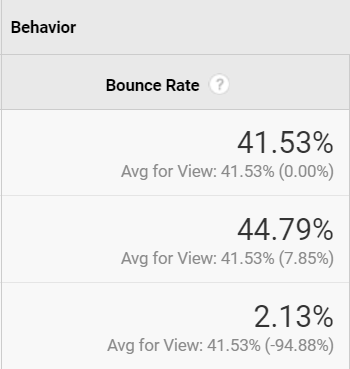Properly positioning your company on the web is a critical step to acquiring new customers or engaging new users. Whether you have a free movie website, a church website, or a small business web site, it is a fact that most people cannot help but judge a company or service they find on the web within just a few seconds of landing on a page. Having an updated website shows the potential customers that you are in business, whether in person or on the web. It also shows that you are invested into providing your visitors with most up-to-date information, quickly. Ultimately, it results in building an effective business web site.
"I came, I puked, I left" is a very famous quote by Avinash Kaushik, when discussing the bounce rate. But what does it mean precisely? At what point is a bounce being recorded? Is it purely when a visitor hits the back button or is there more to it? And what does the bounce rate of a web page imply? In this post, we will discuss what it is, what it means, and what can be done to improve it.
Before we discuss building an effective business web site, let's discuss the bounce rate.
The bounce rate is a simple metric that measures the percentage of visitors that land on your web site, and do nothing on the page they landed on. This means that they did not engage further by clicking on a menu item, a 'read more' link, or any other internal links on the page. A user is considered bounced when there has not been any engagement with the landing page and the visit ends with a single-page visit. A bounce rate metric can be used to indicate the quality of a website and the target of the audience. Google Analytics is one of the most popular web analytic services to track and report website traffic.
According to Google, the bounce rate is calculated as follows:
Bounce rate is single-page sessions divided by all sessions, or the percentage of all sessions on your site in which users viewed only a single page and triggered only a single request to the Analytics server.
In other words, it records all sessions where a visitor only visited one page and divides it by all sessions.
According to Avinash Kaushik, author of "Web Analytics: An Hour a Day", a bounce rate of under 20% is hard to get. Anything over 35% is a cause for concern and anything above 50% is worrying.
Before we dig any further, it is important to note that Google claims it does not use Google Analytics data as a ranking factor. In essence, it would not be reliable for Google to do so, since an incorrect implementation of Google Analytics will provide inaccurate data - therefore affecting search results.
According to multiple Googlers, Google doesn’t use Google Analytics’ data in their search algorithm. But, of course, when people come from a search engine to a site, they don’t bounce back to the search results, since that kind of bouncing probably is a ranking factor. It is very likely to be measured in a different way than the bounce rate we see in Google Analytics.
From a holistic SEO perspective, every aspect of a web site needs to be optimized. Looking at the bounce rate can help optimize the website - which contributes to search engine optimization.
Determining whether the height of the bounce rate is a good or bad thing generally depends on the purpose of the web page. If the purpose is for informational purposes only, then a high bounce rate is not necessarily a bad thing. Of course, we all prefer for people to stick around and read more articles, subscribe, or perform a click-to-action. But when a visitor only visited the page to read a post or find an address for instance, then it isn't surprising they close the page or hit the back button after reading it. Therefore, it is also important to measure the bounce rate for organic traffic sources and new visitors.
If the purpose of the page is to engage visitors with your site, then a high bounce rate is a bad thing. Let's assume your page has one goal: get visitors to subscribe to your newsletter. If that page has a high bounce rate, then the page needs to be optimized. This can be done by adding a clear call-to-action or subscribe button. If that does not work, then perhaps the web site design or the the web site performance is not acceptable. All of these can lower the bounce rate significantly.
But there can be other reasons for a high bounce rate, of course. If you lured visitors to your website under false pretenses, it is no surprise they when these visitors do not engage with the page. Quality traffic is much more important than volume for high conversion.

By looking at the bounce rate from a conversion perspective, the bounce rate can be used as a metric to measure success. For instance, the design has recently been changed in the hopes it will convert better.
Monitoring the bounce rate will indicate whether the changes were right or wrong. An increase in the bounce rate indicates the changes were not correct for the audience.
This very blog you are reading has actually significantly improved the bounce rate from a re-design by an average of over 35%. The bounce rate for some pages was reduced by as much as 94%.
Another way of looking at the bounce rate, is from a traffic sources perspective. Which traffic sources lead to a high or a low bounce rate? Your newsletter for instance? Or a referral website that sends a lot of traffic?
The only way to lower the bounce rate is improving the engagement on the page(s). A web site refresh or new content is a sure way to attract visitors.
If certain traffic sources have high bounce rates, it is important to know the expectations of the visitors coming to the site. If the source is from an advertisement on another site, and most people coming via that source bounce, then your ad is misleading and not satisfying the visitors. The page is simply not living up to their expectations. Review the ad campaign and ensure that it matches the page and page content.
If your page lives up to the expectations of your visitors, and the page still has a high bounce rate, then you have to look at the page itself. How’s the usability of the page? Is there a call-to-action above the fold on the page? Do you have internal links that point to related pages or posts? Do you have a menu that’s easy to use? Does the page invite people to look further on your site? These are all things you need to consider when optimizing your page.
At QWERTY Concepts, we build websites that build businesses. Schedule a free website assessment and or request a quote for your business web site, today.
 Today, the web has undoubtedly become one of the largest financial markets and without organic search engine optimization your web page can be impossible to find. What good is it if it cannot be found? Practically, almost everything is being anchored over the internet. There are millions of websites operating on the web are still rising at an alarming rate. With the ever-increasing emergence of scores of websites running online, the need of Search Engine Optimization or SEO is highly defined. Basically, it is a process involving copious strategies to improve the visibility factor of any website. The optimization strategies consider how the search spiders function and what keywords people usually use. The prime objective of organic search engine optimization is to make websites visible in the search engines through natural (or organic) means.
Today, the web has undoubtedly become one of the largest financial markets and without organic search engine optimization your web page can be impossible to find. What good is it if it cannot be found? Practically, almost everything is being anchored over the internet. There are millions of websites operating on the web are still rising at an alarming rate. With the ever-increasing emergence of scores of websites running online, the need of Search Engine Optimization or SEO is highly defined. Basically, it is a process involving copious strategies to improve the visibility factor of any website. The optimization strategies consider how the search spiders function and what keywords people usually use. The prime objective of organic search engine optimization is to make websites visible in the search engines through natural (or organic) means.
Talking about Organic Search Engine Optimization, well it uses natural techniques or strategies to achieve higher search engine rankings. It is an extremely complex practice that can exactly dictate the success or failure of any online business. Organic Search Engine Optimization (or Organic SEO) also known as natural SEO is used to describe unpaid or algorithm-driven results for any search engine. However, as the search engines often revise their algorithms, this type of search engine optimization is certainly not very easy. When these algorithms are modified, various factors that enable your business website to come in front of your potential customers are also drastically changed. Thus, to deal with all these changes, search engine tactics should be employed by the professionals.
Nowadays, all search sites have become quite advanced and can very easily find out if any website is really trying to use or manipulate the search indexes of their site. Thus, it is good enough to use only organic SEO strategies which appeal completely natural. Various approaches used in organic SEO to that of artificial Search Engine Optimization are totally different. Organic SEO make use of informative and useful content whereas artificial SEO involves technical loopholes. Besides, natural SEO offers attracting links which are completely different to the linking schemes used in artificial search engine optimization. Natural search engine optimization tactics also create valuable resource as opposed to the algorithm chasing of artificial SEO.
Considering all these advantages, one can very clearly make out why organic search engine optimization is more preferable as compared to artificial SEO. Though, the process might be a little complicated, still there is no doubt to the fact that it can produce favorable results which can be extremely profitable for any business website. Fortunately, there is no dearth in the number of companies offering affordable SEO Services. There are scores of companies which are operating over the internet offering professional services of organic search engine optimization services. However, before going ahead and finalizing the deal with any company make sure to perform a background check about the company. Your investigation should include a probe about the authenticity of the company, their reputation in the market, their experience, past record, quality of services along with their rates. You can even chose to make contact with their past customers for a lucid idea about their work and professionalism.
 If you are embarking on the mission to harness the powers of World Wide Web for promoting your business online, then you need to consider two important things pertaining to SEO and design. The first thing is to build up your company or business’s website and the second thing is to promote this website on the internet and the World Wide Web.
If you are embarking on the mission to harness the powers of World Wide Web for promoting your business online, then you need to consider two important things pertaining to SEO and design. The first thing is to build up your company or business’s website and the second thing is to promote this website on the internet and the World Wide Web.
The website should be attractive and eye-catching and should have meaningful content or user friendly services so that the attention of the visitors is completely engaged. Once such a website is ready, you will need to have traffic of potential customers coming to your site which will actually buy your products or hire your services.
The first part of the project can be achieved by hiring one of the well established, experienced and professional website design services while for the second part of the mission, you will need to recruit some good search engine optimization (SEO) services.
This is something very similar to the real life situation. If your website is like your company office or business storefront then search engine optimization services are like placing the ad of your company or business in the yellow pages. The more strategically you are placed in the business listings, the more likely you are to get customers.
The same rules apply when it comes to internet. People looking for a particular product or service use different search engines to find the same. As soon as they input their query in the search field, the search engine gives a list of links that match with their request. These links may be in thousands or millions and run into many pages but the research shows that more than 60% of users select one of the links on the very first page. Thus you need your website to rank higher and appear on the very first page of customer’s search.
One way of achieving this purpose is to use Google AdWords and AdSense features which work on the pay per click system. Although these systems can get you immediate traffic but here you end up paying for the each user that visits your site. SEO or Search engine optimization is another option which you must choose if you are working with a long term perspective.
SEO is a powerful web marketing tool which can help your website achieve higher ranking on the search engines in response to a search request. The way the search engines perform their function of website ranking is different from each other but they are more or less based on the same principles with the dissimilarity being in the preference given to different criteria. The various processes involved in evaluating websites by the search engines are mainly text driven and based on the use of effective keywords and proper backlinks. With organic search engine optimization, the SEO manager ensures that your website has powerful text placed in an intelligent manner which can effectively manipulate different search engine processes to increase your website ranking.
